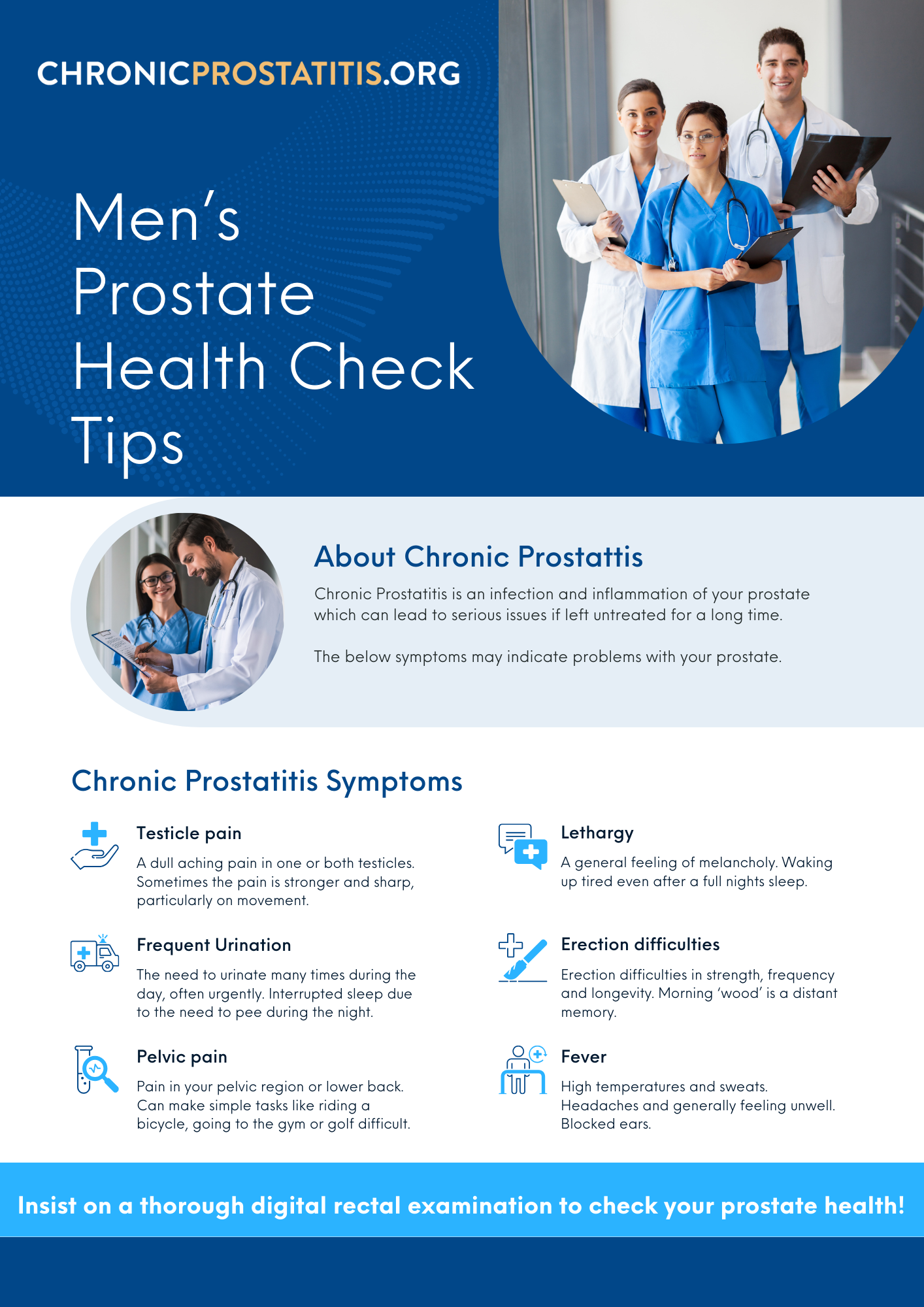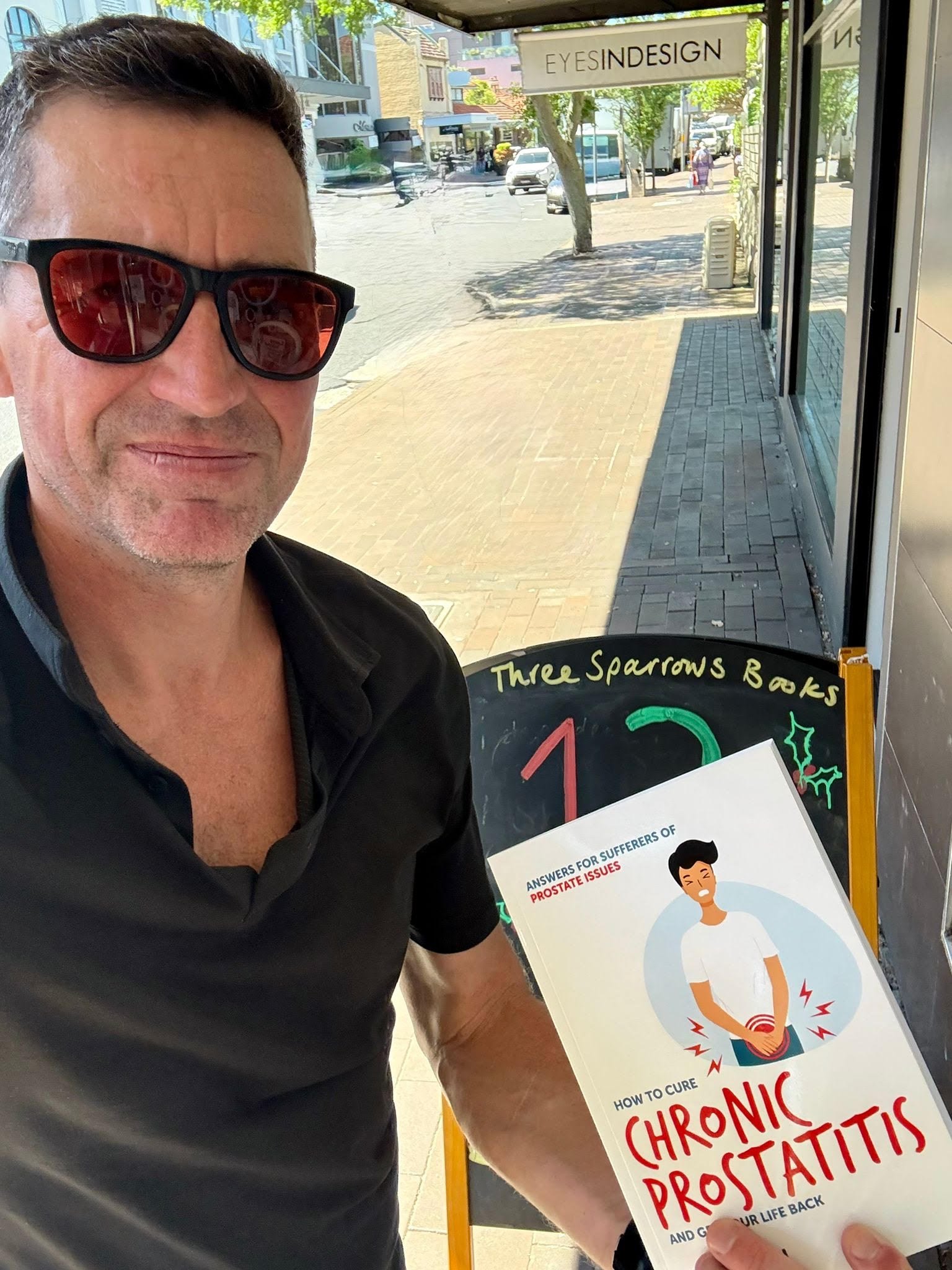Insist on a High-Definition Prostate Scan
Many men are unsure how to even go about getting the health of their prostate checked.
Attached is an example of my own personal prostate scan before I commenced my treatment program. The red areas indicate inflammation and infection which cause over time fibrotic and sclerotic (hard) tissue in your prostate.
I would encourage any man who is suffering from the symptoms on this website to insist on a high-resolution, high definition prostate scan.
Men’s Prostate Health Check Tips
Some useful guidelines on the right tests to get your prostate health properly checked.
How to cure Chronic Prostatitis now in good book stores
Many good book shops are now carrying stock of How to cure Chronic Prostatitis and Get Your Life Back.
Thank you to Three Sparrows Books in Mosman, Sydney for getting some copies in and to Matt Brown for being an early customer.
The book is listed under Prostate Heath under ISBN 978-1-923007-78-9 if you want to get your local store to order you a physical copy.
Symptoms of Chronic Prostatitis
Chronic Prostatitis affects everybody in slightly different ways and every case is unique. Symptoms depend on the bacteria that has entered the prostate and its resistance level. Symptoms also depend on your overall age and physical health, diet and a whole range of other factors. Symptoms usually start out mild and build up in intensity over time.
Common symptoms include.
– Pain, which may be severe, in or around your penis, testicles, anus, lower abdomen or lower back. Pooing can be painful.
– Pain when peeing, needing to pee frequently (including at night), problems starting or ‘stop-start’ peeing, sometimes an urgent need to pee and sometimes blood in your urine. A constant urge to urinate and often a burning sensation when urinating.
– Not being able to pee which leads to a buildup of urine in the bladder. Feeling as if the bladder has not fully emptied.
– Generally feeling unwell, with lethargy, aches, pains and possibly a high temperature.
– An enlarged or tender prostate.
– Headaches and migraines. Some patients complain that they are not able to work or read detailed papers without an excruciating headache.
– Sexual problems such as erectile dysfunction, sub-fertile sperm, pain when or after ejaculating, or pelvic pain after sex.
– Many male sufferers aged 20-35 years old will show irritative symptoms such as pelvic pain, burning sensation on urination and a sense of weight in the testicles.
– A large proportion of males aged 35-55 years old show more obstructive symptoms including varying degrees of dysuria (painful urination) and often an enlarged prostate gland.
– Some sufferers also experience fever and chills.
The symptoms of Chronic Prostatitis can have a significant impact on your quality of life.
Recent studies have indicated 65-70% of the male population suffer chronic inflammation of the prostate. Prostatitis accounts for about two million visits to health care providers in the United States each year.[1]
Cases of Chronic Prostatitis generally depend on many factors including the time the bacteria have been present. Key cases are as follows;
Urgent Cases
The sufferer experiences various intense and persistent symptoms of the Chronic Prostatitis inflammation. They typically attempt to seek immediate medical treatment, often looking desperately for a radical solution because of the degree to which the condition has impacted on their quality of life.
Moderate Cases
The sufferer experiences moderate symptoms annoying enough to eventually warrant a visit to a urologist. Inadequate and often incorrect assessments however lead to ineffective treatment. Persuaded that no satisfactory cure exists the sufferer accepts that somehow the condition is the new normal. Maybe ‘it’s just because I’m getting older’ is a typical sufferer response. As their condition deteriorates, they begin to look for solutions to their problem.
Self-denial
This group does not recognise or do not want to pay special attention to various small or moderate symptoms which begin to occur progressively. Many will undergo surgery sooner or later, either for hyper plasma (the enlargement of an organ or tissue caused by the increase in the reproduction rate of cells, often as an initial stage in the development of cancer) or prostate cancer, because the condition was not treated properly and in good time.
[1] Barry MJ, Collins MM. Benign prostatic hyperplasia and prostatitis. In: Goldman L, Schafer AI, eds. Goldman’s Cecil Medicine. 24th ed. Philadelphia: Saunders; 2011: 805–810.
What is Chronic Prostatitis?
Chronic Prostatitis is inflammation (swelling) of the prostate gland. It can be very painful and distressing. The prostate gland is a small gland that lies between the penis and the bladder. It produces fluid that’s mixed with sperm to create semen.
The disease is essentially an infection, inflammation or disease of the prostate. Harmful bacteria or microbes have entered the urethra and found a comfortable home in the prostate. These bacteria can enter the body through sexual intercourse or contamination. For instance, by urinating in dirty sea or river water. You could even contract it by touching a surface contaminated with germs and then touching the end of your penis. Basically, anything that causes germs and bacteria to enter the male urethra can start Chronic Prostatitis.
Chronic Prostatitis is the end result of a series of inflammatory reactions in the prostate gland that in turn affect the entire genitourinary system.
Despite what many Doctors and publications say, there is only one type of Chronic Prostatitis and that is caused by bacteria.
The bottom line is whether it is called Chronic Pelvic Pain Syndrome (CP/CPPS), Chronic Bacterial Prostatitis, Chronic Prostatitis, Acute Prostatitis or anything else, there is only one version.
“Despite what many Doctors and publications say, there is only one type of Chronic Prostatitis and that is caused by bacteria
I know this because I suffered the symptoms of all of these medical names that are banded around. It was all eventually traced back to bacteria in my prostate causing inflammation.
Chronic Prostatitis is nearly always caused through bacteria in the urinary tract entering the prostate. The urinary tract includes the bladder, kidneys, the tubes that connect the kidneys to the bladder (ureters), and the urethra.
The inflammatory reactions of Chronic Prostatitis are caused by a variety of germs including coliforms, enterococci, staphylococci, and the proteus. In addition, other microorganisms including chlamydia, urea plasma and mycoplasma cause the disease.
Chronic Prostatitis Nutritional Guidelines
It took me a long time to discover ways to control the symptoms of Chronic Prostatitis. I’m sharing what I have learned with you here so you can at least try to reduce any pain or inflammation you have. If you are anything like me you would do anything to subdue all the horrible symptoms you have from this disease.
Diet
It is critical to avoid sugars, spicy foods and alcohol which any microbes in your body absolutely thrive on. They have a comfortable protected place to live in your prostate, do not make them more comfortable and give them the ability to multiply by feeding them the things they like.
If you are suffering from Chronic Prostatitis or the symptoms, I highly recommend you start this diet with immediate effect. It will not cure you, but the symptoms will subside and you will feel better than you currently do. I enclose them to help you here.
NUTRITIONAL GUIDELINES FOR CHRONIC PROSTATITIS SUFFERERS
FRUIT & JUICE
Drink plenty of water.
You can eat fresh fruit but avoid the very sweet ones and their juices. Specifically preferred are green apples, pineapples, kiwi fruit, mangos, plums, cranberries, berries and bilberries, pomegranate and lemon.
Strictly avoid: Soft drinks, alcoholic beverages, packaged fruit juices that contain sugar, bananas, strawberries, cherries and dried fruit.
CHEESE & DAIRY
You should prefer low fat milk and Greek yoghurt with probiotics. Also prefer cheeses that are low in fat and salt (e.g. mizithra cheese, anthotyro, cottage cheese, milner and katiki domokou.
Avoid: Whole milk and yoghurt, hard white or yellow cheeses, soft yellow cheeses that are high in fat. Butter and creams.
SPICY FOOD & SPICES
Strictly avoid: Hot spices and very spicy food. Avoid chili and spicy peppers. You may instead use a bit of cayenne pepper.
You should avoid very salty foods, salted meat or fish, pickles and salted dry nuts.
VEGETABLES
Prefer salads with fresh or boiled vegetables. You may have zucchini, carrots, broccoli, cauliflower, potatoes (roasted or boiled), spinach, lettuce, cabbage, parsley, dill, onions, leeks, artichokes, green beans, okra, tomatoes and cucumber.
Prefer virgin olive oil. Tumeric, cloves, various herbs (e.g. oregano, rosemary, basil), lemon and vinegar.
FISH
Prefer to eat fish along with vegetables (e.g. carrots, mushrooms, tomatoes, okra, greens, zucchini).
Avoid: Salty and salted fish
MEAT & POULTRY
You may eat red meat, chicken and eggs.
Avoid: Smoked meat and fish as well as canned and cured meats. Avoid low quality seed-derived oils, fried potatoes and chips.
In addition, avoid packaged foods and snacks even if they do not contain much sugar or fat.
STARCH & PASTA
Prefer whole grain pasta and bread as well as wild rice.
Avoid: White bread, white flour, white rice, packaged pureed foods and ready-made packaged soups.
DESSERTS
You may have cake and other (unsalted) desserts made with brown flour, fruit or fruit juice, stevia and olive oil.
Strictly avoid: Sugar and patisserie sweets. You should avoid biscuits, pastries, crackers and bakery products that contain sugar.
In addition, avoid chocolate milk and packaged sweets found in stores.
LEGUMES & SOUPS
You may have legumes (e.g. beans, lentils, chickpeas). Prefer homemade soups with vegetables, pulses, rice etc.
In addition, you may have unsalted dry nuts such as walnuts, almonds and cashews.
Acupuncture
Acupuncture involves the insertion of very thin needles through your skin at strategic points in your body. A key component of traditional Chinese medicine, acupuncture is most commonly used to treat pain. Increasingly, it is being used for overall health, wellness and stress management.
I talk in detail in the book ‘How to cure Chronic Prostatitis and get your Life Back’ about my journey with acupuncture. What I can say with confidence is it definitely helped me control the symptoms of Chronic Prostatitis.
I know not all Chronic Prostatitis sufferers don’t have the time and money immediately available to begin a thorough prostate treatment program. Alongside your diet, consider weekly acupuncture treatment combined with daily Chinese herbs from a qualified acupuncturist to manage the symptoms.








